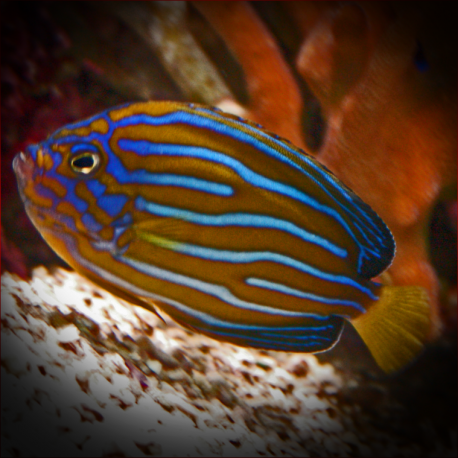More info
Datasheet
| Minimum Tank Size | 700 litres / 184.92 US gallons |
| Maximum Size | 22.0cm / 8.66inches |
| Reef Compatible | Not reef safe |
| Temperament | Might be aggressive towards other species |
| Temperature | 22.2°C / 71.96°F - 25.6°C / 78.08°F |
| Specific Gravity | 1.020-1.025 |
| Carbonate Hardness | 8-12 |
| pH | 8.1-8.4 |
General Description
The Bluestriped Angelfish, scientifically known as Chaetodontoplus septentrionalis, belongs to the Pomacanthidae family. These colorful fish can reach a length of up to 35 cm and are relatively well-suited for aquarium life. They are known for their vivid appearance and are a popular choice among aquarists.
Aquarium Suitability
Considered suitable with care for aquariums, the Bluestriped Angelfish requires specific conditions to thrive. They are hardy in nature but may exhibit aggressiveness towards other species. It is advisable to house them in a large aquarium with ample space for swimming and hiding places, especially when first introduced. Additionally, they acclimatize best when introduced as juveniles.
Demands, Care, and Hardiness
These angelfish demand high water quality and a well-established aquarium with algae-rich environments. Feeding several times a day, especially after introduction, is recommended. They are hermaphroditic, capable of changing gender from female to male, and often live in pairs. The species must be fed a varied diet to ensure their nutritional needs are met.
Reef Suitability
The Bluestriped Angelfish is not considered reef safe as they have a tendency to disturb large-polyped stony corals (LPS) and tubeworms. They may not be suitable for coral aquariums that house delicate corals susceptible to their feeding habits.
Aquarium Setup
When setting up an aquarium for Bluestriped Angelfish, ensure temperatures range between 18-24°C (64-75°F). A tank size of at least 700 liters is recommended due to their territorial behavior. Providing hiding spots, algae-covered rocks, and a well-maintained environment with good water circulation is essential for their well-being.
Behaviour
These angelfish can display territorial behavior and may exhibit aggression towards similar species. They tend to graze on algae from rocks and stones, highlighting the importance of including algae-rich foods in their diet.
Feeding and Diet
Their diet should include larger crustaceans, macroalgae like seaweed and nori, microalgae such as spirulina, small crustaceans like krill, mysis, and artemia, and sponges. Maintaining a varied diet is crucial to their overall health and vitality.
Dimorphism and Captive Reproduction
Bluestriped Angelfish can reproduce in captivity, making them viable options for breeding programs. They are capable of changing gender from female to male, highlighting their unique reproductive adaptability.
Habitat and Distribution
Found in the Western Pacific region, from the Malay Peninsula to southern Japan, these angelfish inhabit cooler waters than typical marine aquarium species. Their natural habitat includes regions with diverse marine life, where they feed on tubeworms and other small creatures.

